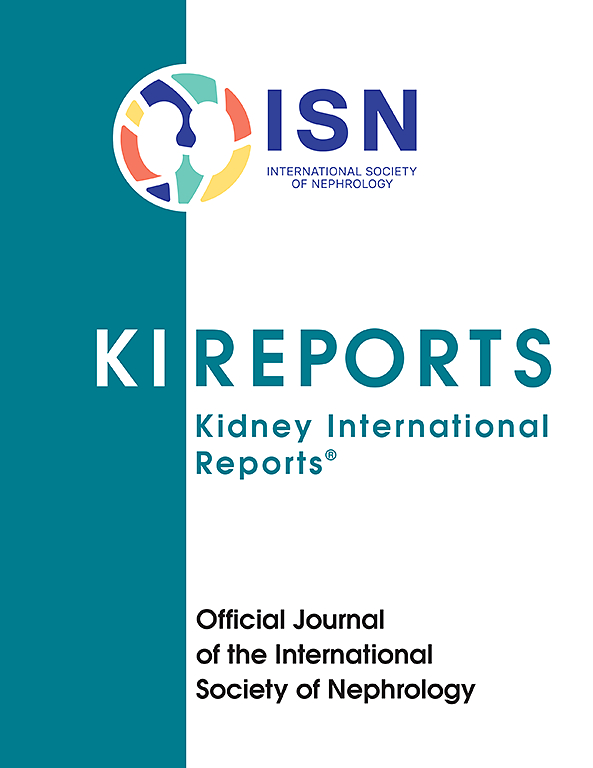苯乙酰谷氨酰胺与CKD认知功能障碍的关系
IF 5.7
2区 医学
Q1 UROLOGY & NEPHROLOGY
引用次数: 0
摘要
慢性肾脏疾病(CKD)导致尿毒症毒素(UTs)的积累。研究表明,ut与CKD患者的认知障碍(CI)有关。最近,有研究报道苯基乙酰谷氨酰胺(PAG)参与CKD和CI之间的关联。然而,这种关联尚未在非透析依赖的成人CKD患者中进行研究。方法CKD-肾脏流行病学与信息网络(CKD- rein)队列研究纳入3033例CKD 2 ~ 5期患者。本横断面分析包括在3个月内进行PAG测量和简易精神状态检查(MMSE)评分的患者。CI定义为MMSE评分≤26分(满分30分)。采用Logistic回归评估PAG与CI之间的关系。结果在纳入的2590例患者中(平均[SD]年龄:67岁,平均[SD]估计肾小球滤过率[eGFR]: 34 [13] ml/min / 1.73 m2,中位数[四分位数间距,IQR] PAG水平:2.1 [1.2-3.6]mg/l), 908例(35%)的MMSE评分≤26分(满分30分)。在调整了社会人口因素(年龄、男性性别和教育水平)、心血管危险因素、脑血管疾病、当前抑郁、eGFR、尿白蛋白与肌酐比(uACR)和已知与CI风险相关的ut后,PAG水平增加2倍与CI相关(优势比[OR][95%置信区间]:1.12[1.01-1.23])。本研究表明,非透析依赖的成人CKD患者血清PAG水平升高与CI相关,并强调了一种新的UT与CKD患者CI相关。需要进一步的研究来证实这种关联的因果性质,并探索降低血清PAG水平以保护认知的策略。本文章由计算机程序翻译,如有差异,请以英文原文为准。

Association of Phenylacetylglutamine and Cognitive Impairment in CKD
Introduction
Chronic kidney disease (CKD) leads to the accumulation of uremic toxins (UTs). Studies have suggested that UTs are associated with cognitive impairment (CI) in patients with CKD. Recently, studies reported that phenylacetylglutamine (PAG) contributes to the association between CKD and CI. However, this association has not been investigated in nondialysis-dependent adults with CKD.
Methods
The CKD–Renal Epidemiology and Information Network (CKD-REIN) cohort study included 3033 patients with CKD stages 2 to 5. This cross-sectional analysis included those with a PAG measurement and a mini-mental state examination (MMSE) score within 3 months of each other. CI was defined as an MMSE score ≤ 26 out of 30. Logistic regression was used to assess the association between PAG and CI.
Results
Of the 2590 patients included (mean [SD] age: 67 [13] years, mean [SD] estimated glomerular filtration rate [eGFR]: 34 [13] ml/min per 1.73 m2, median [interquartile range, IQR] PAG level: 2.1 [1.2–3.6] mg/l), 908 (35%) presented an MMSE score ≤ 26 out of 30. After adjustment for sociodemographic factors (age, male sex, and educational level), cardiovascular risk factors, cerebrovascular disease, current depression, eGFR, urinary albumin-to-creatinine ratio (uACR), and UTs known to be associated with CI risk, a 2-fold increase in the PAG level was associated with CI (odds ratio [OR] [95% confidence interval]: 1.12 [1.01–1.23]).
Conclusion
This study shows that a higher serum PAG level was associated with CI in nondialysis-dependent adults with CKD and highlight a new UT associated with CI in patients with CKD. Further studies are needed to confirm the causal nature of the association and to explore strategies for reducing serum PAG levels to protect cognition.
求助全文
通过发布文献求助,成功后即可免费获取论文全文。
去求助
来源期刊

Kidney International Reports
Medicine-Nephrology
CiteScore
7.70
自引率
3.30%
发文量
1578
审稿时长
8 weeks
期刊介绍:
Kidney International Reports, an official journal of the International Society of Nephrology, is a peer-reviewed, open access journal devoted to the publication of leading research and developments related to kidney disease. With the primary aim of contributing to improved care of patients with kidney disease, the journal will publish original clinical and select translational articles and educational content related to the pathogenesis, evaluation and management of acute and chronic kidney disease, end stage renal disease (including transplantation), acid-base, fluid and electrolyte disturbances and hypertension. Of particular interest are submissions related to clinical trials, epidemiology, systematic reviews (including meta-analyses) and outcomes research. The journal will also provide a platform for wider dissemination of national and regional guidelines as well as consensus meeting reports.
 求助内容:
求助内容: 应助结果提醒方式:
应助结果提醒方式:


